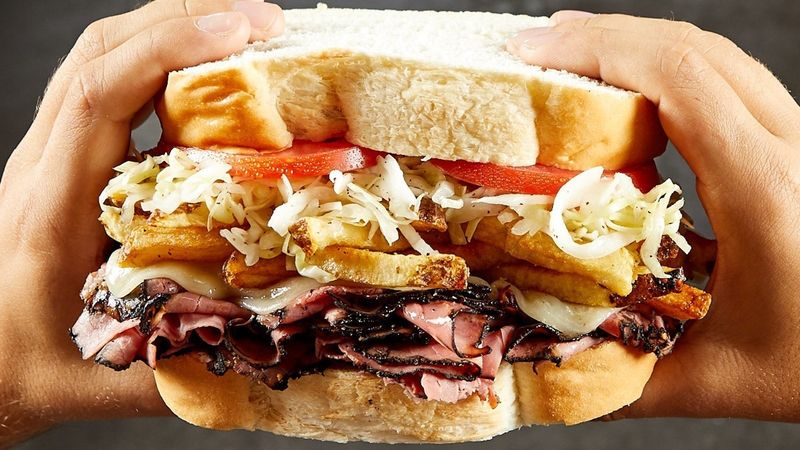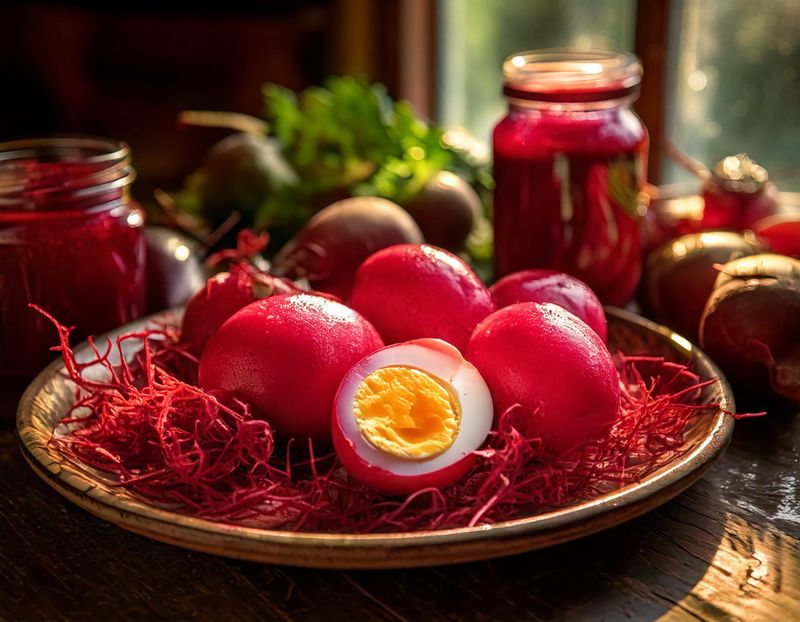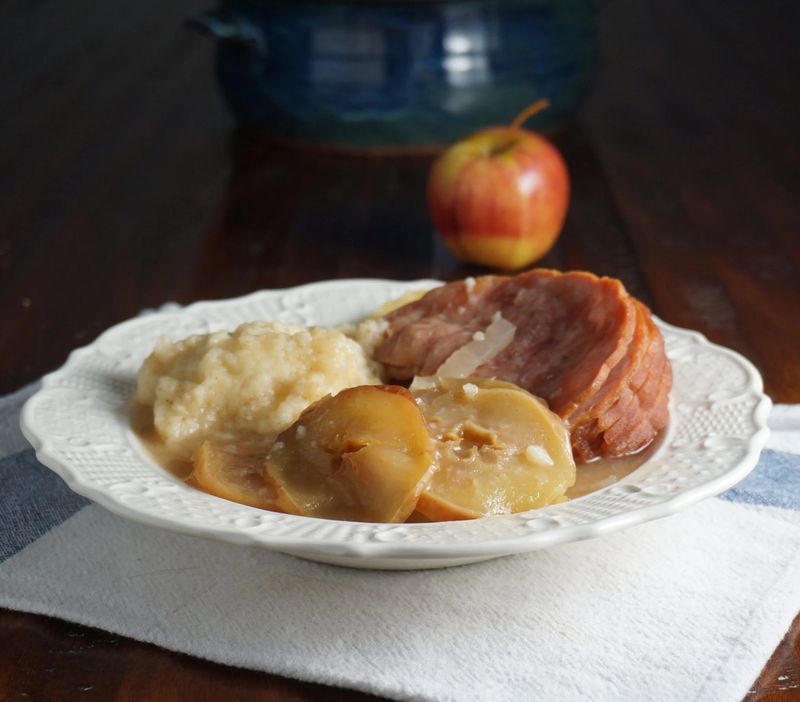Pennsylvania’s rich cultural heritage has created a treasure trove of unique comfort foods found nowhere else. From the Pennsylvania Dutch influences to immigrant traditions and industrial innovations, these dishes tell the story of the Keystone State through flavor. Grab your appetite as we explore these regional specialties that locals cherish and visitors seek out when crossing state lines.
Scrapple – Breakfast’s Crispy Surprise
Nothing says Pennsylvania breakfast quite like a sizzling slice of scrapple. This humble loaf transforms pork scraps, cornmeal, and savory spices into a morning delicacy that’s simultaneously crispy outside and tender inside.
Most outsiders raise eyebrows at its ingredients, but Pennsylvanians know the magic happens in that perfect golden crust. Sliced thin and fried until the edges crackle, scrapple pairs beautifully with maple syrup or ketchup, depending on which side of the sweet-savory debate you fall.
Family diners across the state serve their own versions, but the best often comes from small-town butchers who’ve used the same recipe for generations. Beyond state lines, finding authentic scrapple becomes nearly impossible – making that first bite upon returning home all the more special.
Shoofly Pie – Molasses Sweet & Crumbly
The unmistakable aroma of molasses fills Pennsylvania Dutch country kitchens when shoofly pie emerges from the oven. Legend claims the sticky-sweet filling attracted flies that needed to be “shooed” away, giving this dessert its playful name.
Molasses forms the foundation, while a crumbly topping of flour, butter, and brown sugar creates a perfect textural contrast. Debates rage between wet-bottom devotees (with gooey molasses beneath) and dry-bottom enthusiasts (where filling and crumbs blend completely).
Amish bakeries throughout Lancaster County offer the most authentic versions, often using recipes passed down through generations. What makes this pie special isn’t fancy technique but rather its honest simplicity – a testament to making something extraordinary from pantry staples during lean times.
Tomato Pie – Not Your Everyday Pizza
Walk into any Philadelphia bakery and you’ll spot squares of tomato pie cooling on the counter. This isn’t pizza as most know it – it’s a thick, focaccia-like dough lavished with tangy tomato sauce and just a sprinkle of grated cheese, if any at all.
Served at room temperature, tomato pie emerged from Italian-American bakeries as a practical way to use bread dough and tomatoes. The magic lies in its simplicity: perfectly seasoned sauce atop pillowy dough creates a satisfying snack that doesn’t overwhelm.
South Philly bakeries like Sarcone’s and Cacia’s have perfected this humble staple, selling it by the tray or slice. Outsiders often mistake it for underdressed pizza, but locals know better – tomato pie stands proudly in its own delicious category.
Lebanon Bologna – Old-World Smoky Flavor
Long before artisanal charcuterie became trendy, Pennsylvania’s Lebanon County perfected its namesake bologna. This isn’t the bland sandwich meat found in supermarkets – it’s a deeply smoked, fermented beef sausage with a tangy, complex flavor profile that develops over days.
German butchers brought their wurstmaking traditions to Pennsylvania, but Lebanon Bologna evolved into something uniquely American. The distinctive tang comes from a slow fermentation process, while the dark color and smoky depth develop during extended time in smokehouses.
Sweet and regular varieties exist, with the sweet version gaining popularity for its approachable flavor. Locals enjoy it sliced paper-thin on sandwiches, fried until crispy for breakfast, or simply paired with sharp cheese on a cracker – simple pleasures that rarely travel beyond state lines.
Primanti Brothers Sandwich – The One-Handed Meal
Born in Pittsburgh’s Strip District during the Great Depression, the Primanti Brothers sandwich solved a practical problem for truck drivers and market workers: how to eat a full meal quickly with just one hand. The ingenious solution? Stack everything between bread!
What makes this sandwich revolutionary isn’t exotic ingredients but rather its construction – grilled meat, melted cheese, vinegary coleslaw, fresh-cut fries, and sliced tomatoes all pressed between thick Italian bread. The warm fries and cool slaw create temperature contrast while the bread soaks up the combined flavors.
Steel City visitors often make pilgrimages to the original Primanti’s location, now a 24-hour institution. While the sandwich chain has expanded, nothing compares to watching a skilled sandwich maker construct this Pittsburgh icon at lightning speed behind the counter.
Red-Beet Eggs – Colorful Holiday Taste
Holiday tables across Pennsylvania Dutch country feature jars of startlingly magenta eggs – a simple yet visually striking dish that captures the waste-not mentality of farming communities. These vibrant orbs begin as ordinary hard-boiled eggs before transforming in a bath of pickled beet brine.
The pickling liquid typically combines beet juice, vinegar, sugar, and warm spices like cloves or cinnamon. Left to marinate for days, the eggs develop a tangy-sweet flavor profile while the whites absorb the deep purple-red color from the beets.
Farm families traditionally made these during spring egg abundance and beet harvests, preserving both for leaner times. Modern Pennsylvania potlucks still showcase these colorful treats, especially around Easter. The striking appearance makes them conversation pieces, while their sweet-and-sour profile provides a refreshing counterpoint to heavier dishes.
Schnitz un Knepp – Apples, Dumplings & Ham
When winter winds howled across Pennsylvania farmlands, families gathered around steaming bowls of schnitz un knepp – a hearty marriage of dried apples, fluffy dumplings, and smoky ham. The name itself tells the story: “schnitz” (dried apple slices) and “knepp” (dumplings) combine in a one-pot meal that stretched precious resources.
Dried apples provided crucial winter fruit before modern preservation methods, while the dumplings transformed small amounts of flour into filling sustenance. Ham bones or shoulder infused the broth with rich flavor, creating a sweet-savory balance that defined Pennsylvania Dutch cooking.
Modern restaurant versions are increasingly rare, making this dish a true culinary endangered species. When found, it offers a genuine taste of agricultural Pennsylvania – resourceful, flavorful, and deeply connected to the rhythms of farm life.
Pagash – Potato + Dough Pizza Mash-Up
Carbs-on-carbs might seem excessive until you’ve experienced pagash – the comfort food masterpiece that emerged from Pennsylvania’s coal mining communities. Eastern European immigrants created this hearty dish by combining two staples: potatoes and dough.
The foundation is pizza-like dough topped with seasoned mashed potatoes, caramelized onions, and sharp cheddar cheese. Some versions include sauerkraut or cabbage instead of potatoes, reflecting the diverse Eastern European influences across Pennsylvania’s coal regions.
Church fundraisers throughout Schuylkill and Luzerne counties still serve pagash during Lent, when meat restrictions made this filling alternative especially welcome. While sometimes called “pierogi pizza,” that name misses the dish’s unique identity – it’s neither pierogi nor pizza, but rather a delicious cultural hybrid found almost exclusively in Pennsylvania’s coal country.
Whoopie Pie – Cake + Cream Sandwich
“Whoopie!” – that’s what Amish children supposedly shouted upon discovering these treats in their lunch pails. These handheld desserts feature two chocolate cake-like cookies sandwiching a cloud of vanilla cream filling, creating a portable delight that predates the cupcake craze by generations.
While Maine and Massachusetts claim ownership, Pennsylvania’s Amish communities have been crafting whoopie pies since the early 1900s. Traditional versions feature chocolate cookies with white filling, but pumpkin, red velvet, and other variations now appear at farmers markets statewide.
The secret to authentic Pennsylvania whoopie pies lies in their generous size and balanced sweetness – substantial enough to satisfy but not cloying. Lancaster County bakeries still hand-form these treats, creating slightly irregular shapes that signal their homemade origins and set them apart from mass-produced versions found elsewhere.
Soft Pretzel – Street Corner Tradition
Philadelphia’s street corners have their own distinctive aroma – the yeasty, warm scent of fresh soft pretzels being twisted and baked throughout the day. Unlike their harder German ancestors, Philly pretzels are doughy, chewy affairs with a distinctive squared figure-8 shape.
Pennsylvania Dutch bakers brought pretzel-making skills to the region centuries ago, but Philadelphia developed its own style. These aren’t the glossy mall pretzels found nationwide – they’re denser, chewier, with a slight sourdough tang and just enough salt to enhance the flavor without overwhelming.
Center City vendors still sell them from metal carts, while locals know to seek out bakeries like Center City Pretzel Company where they’re made fresh around the clock. The proper way to enjoy them? With sharp mustard, according to purists, though some controversially prefer them with cheese sauce.
Tastykakes – Nostalgic Snack Cakes
For generations of Pennsylvanians, the cellophane crinkle of a Tastykake package signals pure comfort. These Philadelphia-born snack cakes have been lunchbox staples since 1914, creating a regional devotion that borders on obsession.
Butterscotch Krimpets – spongy, butterscotch-iced finger cakes – remain the signature variety, though Kandy Kakes (chocolate-covered cake with peanut butter) inspire equal loyalty. Unlike their national competitors, Tastykakes maintain a homestyle quality with a less processed taste and texture.
Former Pennsylvania residents often arrange Tastykake care packages from relatives, as the treats remain primarily regional despite limited expansion. Navy ships from Philadelphia historically stocked them, spreading their fame through military channels. The company’s longevity speaks to their formula: simple, consistent treats that taste like childhood, regardless of when you actually grew up.
Roast Pork Sandwich – South Philly Favorite
Philadelphia’s sandwich scene has a delicious secret: locals often bypass the famous cheesesteak in favor of the roast pork sandwich. This South Philly masterpiece layers thin-sliced, juicy roast pork with sharp provolone cheese and sautéed broccoli rabe or spinach on a crusty Italian roll.
The magic happens in the balance – tender, herb-infused pork provides richness, while bitter greens cut through the fat, and sharp provolone adds tangy depth. The roll, slightly softer than a cheesesteak roll, soaks up savory pork juices without disintegrating.
Iconic spots like John’s Roast Pork and DiNic’s in Reading Terminal Market have perfected this creation over decades. Visitors focused only on cheesesteaks often miss this authentic taste of Philadelphia – a sandwich that represents the city’s Italian-American heritage and culinary sophistication beyond its more famous counterpart.
Pierogies – Eastern European Heirloom
Church basements across Pennsylvania’s coal regions and steel towns transform into pierogi factories when grandmothers gather. These half-moon dumplings, filled with potato and cheese, sauerkraut, or prune filling, represent the ultimate labor of love – each one pinched closed by hand.
Eastern European immigrants brought pierogies to Pennsylvania’s industrial communities, where they evolved from special-occasion food to regular comfort meal. The traditional preparation remains sacred: boiled first, then pan-fried in butter with onions until golden, and served with a dollop of sour cream.
Pittsburgh embraces pierogies so completely that giant pierogi mascots race at Pirates games. Church fundraisers still sell out within hours, and families guard their recipes like treasures. While found in other regions with Slavic heritage, Pennsylvania’s versions – particularly those from Pittsburgh to Scranton – maintain an authentic connection to Old World techniques.

















